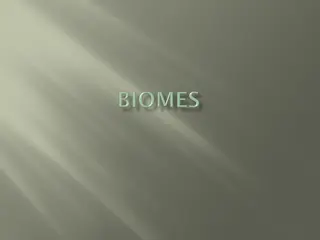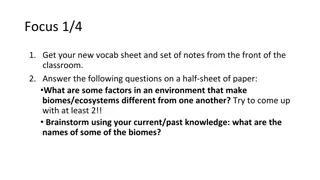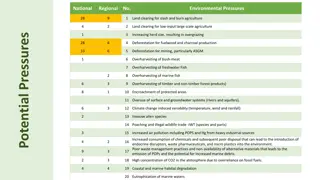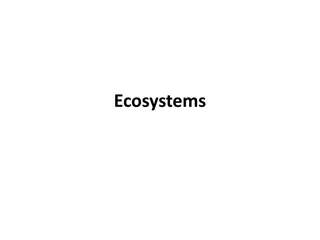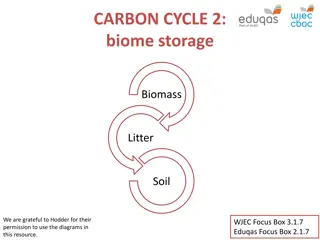Understanding Biomes and Ecosystems in Nature
Exploring the concept of biomes and ecosystems, the interaction between living and nonliving elements in nature, the adaptation of species to their habitats, and the different types of biomes like tundra, forests, grasslands, deserts, and aquatic biomes. The extreme conditions of tundra and deserts are compared, along with examples of adaptations for survival in varying environments.
Download Presentation

Please find below an Image/Link to download the presentation.
The content on the website is provided AS IS for your information and personal use only. It may not be sold, licensed, or shared on other websites without obtaining consent from the author. Download presentation by click this link. If you encounter any issues during the download, it is possible that the publisher has removed the file from their server.
E N D
Presentation Transcript
BIOMES UNIT ONE
Ecosystem Includes all things, living and nonliving, that interact with one another in an area of land. It can be as small as the area under the rock or as large as a mountain.
A species of any animal or plant survives because it adapts to the habitat where it lives. A species is a group of plants or animals with the same characteristics.
Biome A biome is made up of different ecosystems found together in a single geographical zone that share the same climate conditions. The five major life biomes are: 1- Tundra 2- Forests 3- Grasslands 4- Deserts 5-Aquatic biomes Some of these have moderate conditions, others have extreme conditions like Tundra and Deserts.
Examples of extreme conditions and comparison between Tundra and Deserts: Tundra Desert Hot and dry. Temperatures rarely go above freezing. Very little amount of water. A lot of the prey lives in the ocean. Windy and sandstorms. Long distances between food and water supplies. Very bright sunlight reflecting off the snow.
What is adaptation? What is adaptation? Adaptation is the physical characteristic of an organism that helps it to survive better in the surrounding environment.
Examples of adaptations that some animals or plants have: - Birds have different shaped beaks according to their diet, examples: a long curved beak is for eating nectar from flowers, where a curved sharp beak is for eating flesh (meat). - In plants, the bright colored petals of the flower attract insects for pollination. - In plants, most leaves surfaces are flat to take the maximum amount of light needed to make their food.
A frog has long sticky tongue that helps it to catch insects. Birds have streamlined body shape to fly easily. Camouflage is an adaptation that allows an organism to hide in the surrounding. Examples: a white rabbit hides in the snow.
Adaptations of a Camel For storing fat. To protect their eyes from the sand. Thick fur: To protect against the sun s heat during the day and to provide warmth during night. To help walking in the sand.
Cactus adaptation: - Cactus have spines instead of leaves. These minimize the surface area and so reduce water loss. - Cactus have widespread root systems that can collect water from a large area. - Cactus have large stems that can store water.
Adaptations of a Polar Bear Transparent fur to camouflage in the snow Long, thick, curved claws so it can walk on snow. Thick layers of fur and body fat to keep it warm. Large paws so it can walk on the snow.





